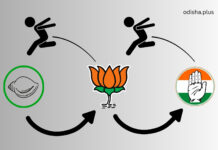Suresh Chandra Sarangi
A 360-degree analysis of the union budget for 2022-23.
Nirmala Sitharaman, the finance minister of India, presented a blockbuster budget for the financial year 2022-23. With a total expenditure outlay of Rupees 39.45 lakhs crore and projected fiscal deficit at 6.4% of GDP for the financial year ending in 2023 against the FRBM mandated 3.0% fiscal deficit, on the backdrop of the debilitating impact of COVID-19. It has been predicted in the economic survey for FY 2022-23, the expected GDP growth would be around 9.2% against the IMF assessment of 9.0%, which is the fastest growth among the nations.

Many economists are of the opinion that the budget envisages a structural shift with a changed tone and tenor vying for sustainable economic growth orientation while the opposition parties made a vituperative attack on budget day and blistering acrobatics on the floor of the parliament on the following day of the presentation of the budget alleging that there is precious little in the budget to tame inflation, price rise and solve the humongous unemployment problem the country is witnessing today, thereby dashing the hopes of the common man. There is no scope for tax incentives or tax rationalization for the middle class and thus the budget widens the chasm between the rich and the poor, resulting in inequality of magnified proportions.
The treasury bench is of the opinion that the reforms measures contained in the budget shall set a chain reaction of economic activities which is self-generating and favorable to growth momentum as well as distributive justice. No doubt with rising geopolitical tensions, oil reaching the US $90 per barrel, the budget aims at the construction of 25000 kilometers of new roads, 60 lakhs new jobs, 400 new Vande Bharat trains, 100 cargo centers connecting of five rivers, extension of additional support of Rupees 2 lakh crore, e-vidya, Har Ghar Nal Jal, affordable housing in urban centers, core banking solutions at 1.5 lakh post offices, e-passport, Bharatnet plan, encouragement of organic farming, issuance of sovereign green bonds, creation of sovereign digital currency using block chain, allocation of addition Rs 1 lakh crores as revenue to states, taxation on virtual digital asset transfer.

The four edifice on which the budget stands and supported is based on PM Gati Shakti, inclusive development, sunrise opportunities, energy transition and climate action. It envisages inclusive development and financing of investment. It is a rejoicing fact that in spite of the gruesome spreading of COVID-19 destabilizing the economy with huge migration of labor, the country has reflected resilience resulting in a buoyant tax revenue. PM Gati Shakti shall be driven by 7 engines such as roads, railways, airports, ports, mass transportation, waterways and logistic infrastructure which signifies that India is on the move.
This budget is a huge bet on growth, investment, infrastructure creation, both physical and social with a focus on sustainability standing on a digital platform with emphasis on exports, inclusive growth, and financial inclusion and revamping of education and skills. The route adopted by the Government is long term growth orientation with a major structural reform which is a paradigm shift from the populist budget of previous year. Investors smell a potential for sustained corporate profits.

Rakesh Jhunjhunwala, the topmost bull, while replying to the press people said that the budget is bullish in its tone, from various reform measures contained in the budget, it appears liberalizing the ease of doing business remains the mainstay of Government’s future planning. The huge expenditure and creation of capital assets will go a long way in solving unemployment problems and integrate the entire nation in a befitting manner.
Atleast, a large section of people sops and freebies during this year’s budget when 5 state governments are going for elections including the crucial state of Uttar Pradesh. But the Government has steered clear of the controversies by remaining away from the sops which is a new mode of approach of the thinking in the government stressing more on development. The most frustrating experience was that of the salaried class, middle class and senior citizens as regards non-revision of IT slabs or no change in deduction under various sections that helps a wide section of people liberate huge sums of money in the hands of the individuals for pushing of demand with increased consumption.

Technology is a big push and remains a focused area that shall streamline growth and enhance reforms and thus adoption of drone technology etc., is futuristic in nature. Thus, rolling out a roadmap for total digital transformation with additional emphasis of digitization in all the sectors including a creation of sovereign digital currency makes a strong case for digital infrastructure. So, the budget strikes at implementation of welfare economics as well as a digitized knowledge economy with scheduled commercial banks support in this transformation. Extension of ECLGS with focus on the hospitality sector, revamping of CGTMSE, enhancing additional allocation of 2 lakh crores to MSME sector will set off a chain reaction of intense economic activities.
The December export figures at 37.5 billion speaks of the emphasis on manufacturing. The importance of organic agriculture, which is chemical less fertilizer, is a new approach in agrarian reforms. Increased allocation of MSP is a pointer to the fact that the farmers are assured of pickup of their produce that will give fillip to increased agricultural output.
The budget proposals no doubt aim at consolidation with overall emphasis in strengthening both supply and demand sides. Thus, it is bold in its approach and is a balance between fiscal prudence and economic growth. This lays down the foundation of sustainable growth opening a virtuous cycle of private investment as well as encouraging crowding in of private investment.
Despite criticism, the Finance Minister while addressing the press after the budget was the instruction of the Prime Minister in a pandemic year no additional tax to be loaded on the people for which there is no additional tax imposition continuously for 2 years. All said and done the budget sets a chain reaction of millions of mutinies and promises of Atma Nirbhar Bharat.
(The Writer is a former General Manager, Bank of India and lives in Bhubaneswar.Views are personal)





















